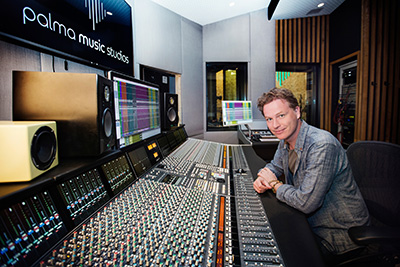A new ground-up commercial facility on the Balearic island of Mallorca, Palma Music Studios offers flexible production spaces. Among these, the Quincy Room is equipped with a 48-channel Solid State Logic Duality δelta SuperAnalogue console and is complemented by the Wonder Room live space.
 The facility was initially the family home of Swedish producer/songwriter Fredrik Thomander, following creative bases in Stockholm and then Los Angeles. Thomander is joined in the venture by musician, gearhead and EasyJet Chief Executive Johan Lundgren.
The facility was initially the family home of Swedish producer/songwriter Fredrik Thomander, following creative bases in Stockholm and then Los Angeles. Thomander is joined in the venture by musician, gearhead and EasyJet Chief Executive Johan Lundgren.
‘At some point, the artists I was working with realised that I was living in Palma,’ Thomander explains. ‘And they started saying – “screw that, you’re not coming to us, we’re coming to you”.’
Without a permanent studio in Palma, Thomander used apartments and houses as temporary spaces to accommodate his visitors. Just over two years ago, he met Lundgren: ‘We became friends and collaborators, and at some point Johan said, “it’s strange that artists are coming to you in Palma and you don’t have a studio, but I have a studio with no artists and want to be in Palma”.’
After buying a plot of bare land, the pair set about designing the studio, and broke ground in January 2017. Nick Whitaker was the Acoustic consultant on the project, and Paul Ward (Oxford Studio Systems) was brought in for wiring and infrastructure. The building has eight floating zones and the creative spaces span three floors, starting with three project rooms, a vocal booth, and a larger production studio at the basement level.
‘That’s our writing camp floor for modern/EDM production floor,’ says Thomander. ‘Five or six producers can work at the same time with a few artists, using the big room as the mothership, and the smaller studios as satellites.’
The ground floor has the Quincy Room with its large SSL control room and Wonder Room live space (with street-level load-in and 8m ceiling), vocal booth and amp booth. Above the booth spaces is a balcony/hospitality area for the Wonder Room, and the third floor has the Winehouse Room – a 5.1 studio for postproduction services – along with the lounge and kitchen area. The facility is topped by with a rooftop terrace, which is also wired for sound.
‘We could do a Beatles-on-the-roof thing overlooking Palma,’ Thomander says. ‘Or, if people want to shoot YouTube videos, do unplugged sessions, stuff like that, it’s perfect.’
The Duality δelta consoles started life as a 24-channel frame, owned by Lundgren. ‘He had looked at plenty of other consoles,’ says Thomander. ‘I think he just fell in love with the intuitive interface, how good it sounded, and the integration with Pro Tools – basically everything about it.’
For the Palma Studios development, Thomander added 24 channels: ‘We can now mic everything here, bring outboard effects back into the console, stems from Pro Tools, and we don’t run out of channels. We have everything in the studio miked up and ready to go, or we can flip and have a clean desk with all channels for mixing.’
Thomander himself had spent a long time in the in-the-box wilderness before realising the advantages of the hybrid approach, and bringing his own DAW workflow to the console.
‘I sold my old Amek Angela desk in 1999 and have spent the last 20 years working in the box. I’m getting into the SSL now, bringing all my workflows with me, and it’s proven to be fantastic. The sound is amazing.
‘A big change for me has been rethinking the mix bus. It’s been really exciting to work with several analogue mix buses. I use the SSL’s Mix Bus Compressor on Bus A, and I insert outboard EQs and compressors on C and B and blend them. That’s been great. And since I have been working with the mix busses like this, we have set up a way of printing alternative mixes onto another computer through top-quality convertors at 88.2kHz. That feels very luxurious and cool.’
The Duality’s comprehensive DAW control features and δelta-Control (DAW-based automation) are also giving Thomander’s workflow a boost: ‘I’ve bought several different control surfaces through the years, but never used them – eight faders here and there that never get touched. The Duality is a complete instrument, which is very exciting. It’s a good time to build a studio today, where digital and analogue worlds work so well together.’
Thomander notes that he and Lundgren always intended Palma Music Studios to exceed expectations, particularly in a location that has the potential to outshine the facility itself. ‘We couldn’t just build an “okay” place and have people say “it’s good, but we’re really going because it’s in Mallorca”. We want people to say “it’s a great studio and it’s on Mallorca”.’